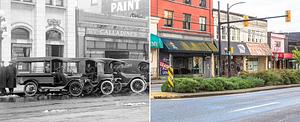What's New

added November 30, 2020
Main Street between 7th and 8th
Mount Pleasant was Vancouver's first suburb, providing affordable homes to working class families in the city. Calladine's Grocery offered home delivery to the area. (1908 photo from Vancouver City Archives).

added November 30, 2020
1024 Cardero
These two homes were built around 1908, and one is now a popular coffee shop for the West End crowd. The other one got a new hat!

added November 30, 2020
Little Cottage Confectionary and Grocery
I imagine a lot of love went into the transformation of this corner store, built in 1910, into a beautiful home. It's getting hard to find these little neighbourhood retail relics, although I recently came across a good trove of old photos so I'm going to focus for a while on finding the remaining ones in the City.

added November 30, 2020
Cardero Grocery
One of the West End's first convenience stores, the Cardero Grocery opened up in 1902 and closed in 2017 and it, along with the house next door, were sold to an investment company for around $4 million. Both builldings have recently been renovated and the store is set to open very soon. The houses were built in the early 1900s. (1978 photo from Vancouver City Archives).

added November 30, 2020
Seaforth Armoury
Home of the legendary Seaforth Highlanders, formed in 1910. Their members suffered heavy losses in battles over the years, including Vimy Ridge and Passchendaele. During the Second World War they collected 25 battle honours, and 'wrote the book' on urban combat for the Canadian Army. In 1945, they were welcomed home by over 200,000 Vancouverites. (1936 photo from Vancouver City Archives).

added November 30, 2020
Bessborough Armoury
This picture was taken the year the Armoury was built. A 2010 book about the home of the 15th Field Artillery Regiment highlighted the challenges of getting financing for construction during the Great Depression. Its Heritage Designation ensures that it will remain a Kitsilano fixture for many years.

added November 30, 2020
Helen's Grocery
Built in 1912, this store has been a Kitsilano fixture for generations. The valuable property is slated for a two-family, two storey dwelling in the near future.

added November 30, 2020
Japanese School
Built to educate the children of Japanese immigrants who came here in the late 1800s, the building is now a national historic site. The treatment of people of Japanese descent was pretty heartless during World War II, as property was seized and families forced into internment camps. This property is the only asset that was returned to the Japanese community after the War.

added November 30, 2020
Arbutus Coffee
Built in 1907 and originally called the Eureka Grocery, the neighbourhood grocery store was conveniently located next to the interurban rail line that ran to Steveston. Those train tracks became a popular bike path a few years ago, and lots of cyclists now stop here for coconut water and home-made cranberry flax muffins. (1978 photo from Vancouver City Archives).

added November 30, 2020
Clarendon Hotel, 1907 and 2020.
In 1907, the year this hotel was built, the 900 block of Main Street was a popular stop for people coming from New Westminster and the US to the busy port of Vancouver. It's one of a small group of buildings that owe their existence to the fortunes of the Klondike Gold Rush. In between the two pictures below, the Clarendon changed its name to the American Hotel, and it became known for drugs and violence. A recent renovation has made it a popular destination for burgers and beer. (1907 photo from Vancouver Public Library).
Displaying posts 251 - 260 of 313 in total
Loading...